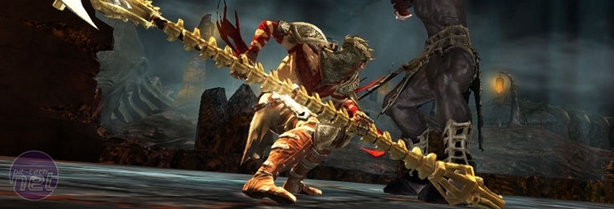
Dante’s Inferno Hands-on Preview
Platform: PlayStation 3, Xbox 360, PC, PSPPublisher: Electronic Arts
Expected release date: 2010
Jonathon Knight and the team at Electronic Arts’ Redwood Shores studio have a fight on their hands when it comes to persuading gamers that Dante’s Inferno is anything other than a rip-off, and they know it. Or, at least, the team members we spoke to seemed so desperate to be taken seriously that that’s the conclusion we were left with.
Gamers are, broadly speaking, a cynical lot and won’t easily be tricked into thinking that “this is what Dante Alighieri would have wanted” no matter how insistent exec producer Jonathon Knight is. As gamers ourselves, that cynicism is something we share in and it’s heightened by the knowledge that Dante wrote the Divine Trilogy as a way of exploring religious dogma and testifying his love for the real-life Beatrice Portinari. He definitely didn’t write it so it could be adapted into a violent hack and slash videogame.
Then again; who care’s what Dante wanted? Sucka’s been dead for so long his work has fallen into the public domain, so there’s really nothing to say that EA shouldn’t pick up the idea and explore it in its own way. Or exploit it in its own way, for that matter – which is, without meaning to pre-emptively slam the work of the developers, what the game is all about.
You see, it doesn’t matter how carefully polished or how relevant and intelligent the game itself is or tries to be, the very idea of taking a work from the public domain, adapting it to suit your purpose or audience and then making lots of money from it is, by its very nature, exploitative. That’s true regardless of the quality of the final product.
Now, with that off our chests and out in the open, we can take a look at the game itself and the new story therein. While the idea with fiddling with the plot of such an established masterpiece may seem a little disrespectful, the story changes have come about mostly out of necessity. The idea of being guided around such an interesting place as Hell, but being ultimately unable to interact with anything would make for a frightfully dull game – something handily proved by Star Trek: The Captain’s Chair.
The revised premise for Dante’s Inferno is as predictable as they come compared to the ingenuity of the original work, but that’s forgiveable as it at least meshes well with the game as a whole. Dante’s Inferno is basically a revenge/love story, with the titular Dante re-imagined as a stubble-chinned soldier haunted by his previous atrocities. EA’s Dante is a survivor of the crusades, is armoured by a crown of thorns, has a vermilion cross emblazoned on his chest and carries a colossal, jewelled ‘death scythe’ as a main weapon.
As far as the symbolism goes then, Dante’s Inferno has all the subtlety of a blender to the nether-regions.
The beatific Beatrice is cast in the game too, though this time not as Dante’s guide through heaven but instead as the damsel in distress. Beatrice who, just as in the poems, was Dante’s embodiment of all things holy and good-looking, has been murdered by Death (wait, what?) and her soul has been dragged down to hell. Convinced that isn’t where she is supposed to be, Dante wages war against Lucifer himself in an effort to give Beatrice the afterlife he thinks she deserves.
Go then, thou muscle-bound, scythe-wielding crusader! To hell with you if thy hope to save thy wench! And, um...avast, me hearties, or something?

MSI MPG Velox 100R Chassis Review
October 14 2021 | 15:04











Want to comment? Please log in.